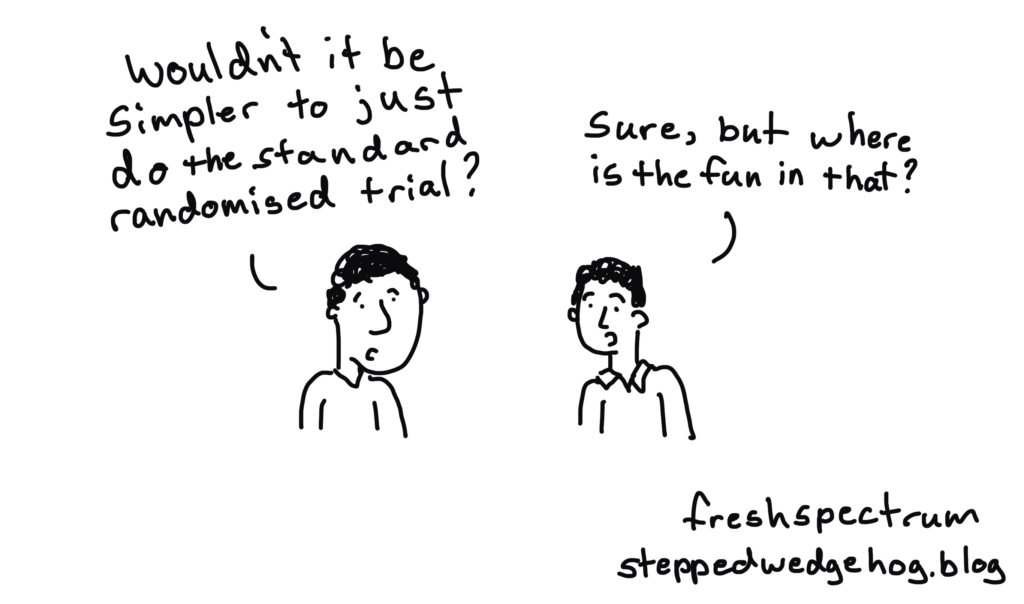Table Of Content
- The stepped wedge cluster randomised trial: rationale, design, analysis, and reporting
- Side Swept Bangs
- TRESemmé TRES Two Mega Firm Control Gel
- Considerations Before Selecting a Stepped-Wedge Cluster Randomized Trial Design for a Practice Improvement Study
- Stepped Wedge Cluster Randomized Designs for Disease Prevention Research
- Table 2
- Associated Data
- Keywords

In our review, most conducted trials did not raise serious concerns for major carry-over effects, but it is unclear whether these were considered. We have described why the possibility of carry-over effects should be considered for SWTs in which individuals experience both control and intervention conditions. The continuous recruitment design is an attractive design since each participant experiences only one condition, and in many cases needs to provide only one outcome measurement. The closed cohort design, with repeated measurements on the same individual, may be problematic because individuals experience both conditions, but it can be a very powerful design.
The stepped wedge cluster randomised trial: rationale, design, analysis, and reporting
The entries in the table in Box 1 show how the width of this confidence interval, and therefore the statistical precision of the estimator, is affected by the parameters underlying the trial design. Characteristics of the clusters and individuals were summarised by group of randomisation. The primary outcome was prevalence of depression, and this was analysed using a linear mixed model, adjusted for calendar time and with a random effect for nursing home and allowing for repeated measures on the same individuals (using a random effect). The adjusted (for calendar time) effect size was −7.3% (95% confidence interval −13.7 to −0.9), which means an estimated 7% reduction in prevalence of depression after the introduction of the intervention. As a methodologist with the Ottawa Methods Centre, Dr. Taljaard works with clinicians and researchers from a variety of disciplines and medical specialties in the design and analysis of cluster randomized trials, standard clinical trials, and observational studies.
Side Swept Bangs
The Hughes et al. [12] protocol includes time as a component in the model, but the analytical approach to be taken is not clear. Cook et al. [17] and Priestly et al. [22] also consider the impact of time on effectiveness. The latter uses matched pairs of wards to control for inter-temporal changes, randomising one ward in each pair to early intervention and one to late intervention. Analysis is then undertaken using a sub-set of three 4-week time periods for each ward pair, comparing the outcomes in intervention and control wards across the same 12-week period.
TRESemmé TRES Two Mega Firm Control Gel
Tailoring Drug Interaction Alerts to the ICU Reduced Number of High-Risk Combos - Medpage Today
Tailoring Drug Interaction Alerts to the ICU Reduced Number of High-Risk Combos.
Posted: Tue, 23 Jan 2024 08:00:00 GMT [source]
Individual informed consent was elicited from residents, though residents and staff were blinded to the allocation. Most residents were recruited at the start of the trial and followed up over the five steps; others were recruited during the trial and followed up for any remaining steps. The stepped wedge cluster randomized design has seen a rapid increase in popularity over the past decade. The stepped wedge is different than the conventional parallel arm cluster randomized design in that all clusters (e.g., communities, schools, or hospitals), rather than only half, receive the intervention. The reported challenges of SW-CRT design for use in large-scale primary care studies were related primarily to the long time frame of SW-CRTs, resulting in challenges with site retention, the heavy burden of data reporting, the Hawthorne effect, and possible confounding with temporal trends.
Considerations Before Selecting a Stepped-Wedge Cluster Randomized Trial Design for a Practice Improvement Study

The study randomised 16 hospitals in groups of two to four to begin the intervention at one of five steps, with a median step length of two months and a total rollout period of nine months (Fig. 3c). Outcome data came from observations of staff compliance carried out every six weeks over the study period, and collected at the hospital ward level. The timing of these measurements does not seem to be linked to the trial steps or other aspects of the design. While it is not reported directly, we assume that there would be staff turnover during the trial as it is relatively long, and so we view this as an SWT with an open cohort design. Although the intervention is ‘delivered’ to staff, the outcome measurement is collected for a ward and pooled across the staff working the shift at that time. Data are collected over 39 months, including nine months before the rollout and 21 months after rollout has completed.
Mhurchu et al. investigated the effect of providing free school breakfasts on pupils’ attendance [10]. Fourteen schools participated, and each school provided a closed cohort of pupils for one school year (Fig. 3b). After randomisation at the start of the school year, the intervention was rolled out to groups of three to four schools over four steps of length 2.5 months each (school terms). The primary outcome, school attendance, was assessed for each child and each term using a binary outcome indicating whether attendance was less than 95 % of that expected. No outcome data were collected when all of the clusters were in the control condition, but some were collected during the final term when all schools were in the intervention condition. All participants are identified at the onset of the trial and participate from start till end, typically without any changing clusters.
Table 2
During his 40-year career Bass worked for some of Hollywood’s most prominent filmmakers, including Alfred Hitchcock, Otto Preminger, Billy Wilder, Stanley Kubrick and Martin Scorsese. It also happened to one of the smallest and was the least expensive of the Case Study Houses to build. CSH 20(B) also demonstrates quite well that the relationship between the architects and the home owners need not be a clash of personal ‘wants’ versus design ‘solutions’.
The other trial by Williams et al. involved measurement only of patients first exposed shortly before a crossover point, and they are seemingly exposed to intervention or control, but not both [13]. In a typical SWD trial, the intervention is begun at a time point that varies from cluster to cluster. Until this time point is reached, all participants in the cluster belong to the control arm of the trial. Once the intervention is begun, it is continued without change until the end of the trial period. At the first time point of measurement, no intervention has yet begun in any cluster; at the last one, the intervention is in progress in all clusters.

All FitFlop’s shoes are biomechanically engineered for joint alignment, and the Eloise, with its triple-density cushioning, is more stable and easier to walk in than your average wedge. Bass designed some of the most iconic corporate logos in North America, including the Bell System logo in 1969, as well as AT&T’s globe logo in 1983 after the breakup of the Bell System. He also designed Continental Airlines’ 1968 jet stream logo and United Airlines’ 1974 tulip logo, which became some of the most recognized airline industry logos of the era.
Likewise within our review, the SWT conducted by Dreischulte et al. involves data collection from clusters only in certain periods before and after the crossover [16]. We feel unable to recommend these ‘sparse’ designs, with potentially few clusters providing data at each time point in the trial, until further confirmatory methodological work is conducted, but acknowledge their appeal. Trialists must choose the number of steps and the time between successive crossover points (or step length) with the total trial duration and sample size requirements in mind.
Repeated measurements are typically taken from the same individuals to assess change and its relation to exposure. Once the layout of the design has been determined, the individual clusters (or groups of clusters) should be randomised to their positions within the design. In the EPOCH trial, hospitals were divided into geographical groups (to facilitate simultaneous rollout within groups), and these groups were randomised to the implementation start date (that is, the “rows” of the design in fig 2⇑). In any stepped wedge design the steps of the wedge divide the study duration naturally into separate observation periods. Some designs make special allowance for the length of time it takes to embed the intervention into a cluster (example 4). During such transition periods the cluster cannot be considered as either exposed or not exposed (fig 1d⇑).
When designing a stepped wedge cluster randomised trial, the number of clusters, number and length of steps, and number of clusters randomised at each step need to be determined. For example, the availability of suitable clusters may limit the number of clusters included. When the motivation for using the stepped wedge design is that it may be impossible to intervene simultaneously in all clusters (as in example 3), the study duration is dictated by the system’s capacity to implement the service change. The number of observations per cluster is often determined by the number of participants meeting eligibility criteria. Design features that are not fixed by logistical constraints can be chosen with the aim of maximising statistical efficiency (a point to which we return). The chosen design can then be illustrated schematically, as in example 4, the EPOCH trial (fig 2⇓).














